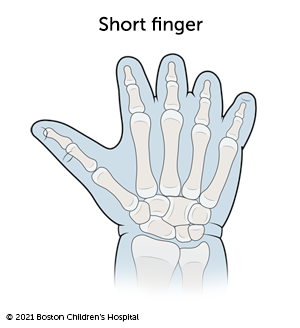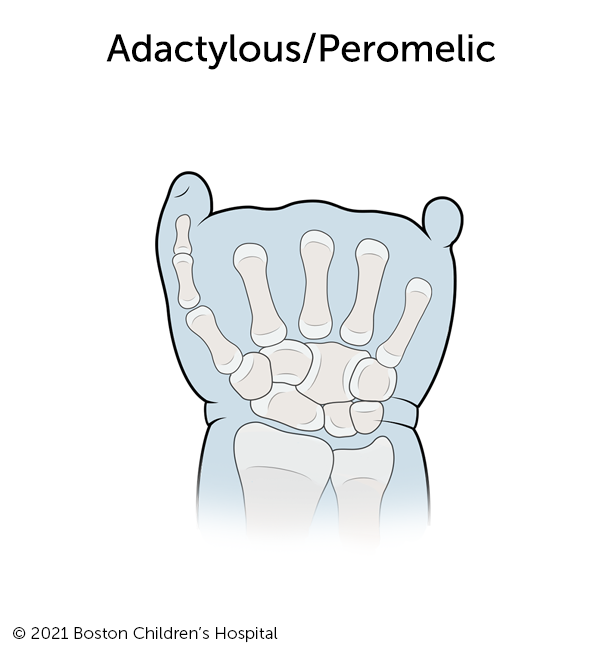Symbrachydactyly | Symptoms & Causes
What are the symptoms of symbrachydactyly?
Symbrachydactyly is visible when your baby is born or shortly after their birth. Your child’s fingers will be short and webbed. In severe cases, your child’s fingers will be small stumps of skin and soft tissue. These differences may make it difficult for your child to use the affected hand.
What causes symbrachydactyly?
In most cases, children are born with symbrachydactyly for no known reason and without any other abnormalities. The condition is not thought to be inherited or to run in families.
Sometimes, symbrachydactyly is part of a genetic syndrome called Poland syndrome. This causes an underdeveloped chest muscle on one side of the body.
Symbrachydactyly | Diagnosis & Treatments
How is symbrachydactyly diagnosed?
Symbrachydactyly is most often diagnosed at birth during the newborn exam. Sometimes it is visible on a prenatal ultrasound.
Your baby will have x-rays so their doctors can look more closely at the underlying structure of their fingers and decide on treatment.
Symbrachydactyly is often confused with amniotic band syndrome (also known as constriction ring syndrome). The main difference is that symbrachydactyly often involves malformation of underlying structures of the hand (muscles, nerves, bones). Amniotic band syndrome happens when a strand of the amniotic sac constricts a normally developed finger, toe, or limb while a fetus is developing.
How is symbrachydactyly treated?
Treatment for symbrachydactyly varies from child to child and the severity of the condition. Some children do not need surgery or only have minor skin and soft-tissue corrections. Other children need surgery to improve function and lengthen the affected fingers.
Surgery to separate fingers is usually done between the ages of 1 and 2 years old. Some children need additional surgery when they are older.
Types of surgery for symbrachydactyly
A child with severe symbrachydactyly may need to have bones transferred to their hand to add length to the affected fingers. Typically, the bones come from the toes. In some cases, a toe or multiple toes are transplanted to the affected hand (a process called toe transfer or toe-to-hand transfer). The goal of this surgery is to give your child the ability to pinch, pick up, and hold objects.
Complications right after surgery are uncommon and usually minor. But medium- to longer-term complications can include:
- infection
- poor bone healing
- stiff knuckle joints
- finger dislocation
After surgery, children typically wear an above-elbow cast for three weeks to immobilize and protect their hand. Once the cast is removed, a splint that slides in between the fingers and keeps them apart is used for an additional six weeks. During this time, many children have occupational or physical therapy to help reduce scarring, stiffness, and swelling, and improve function.
What is the long-term outlook for children with symbrachydactyly?
Surgery can be very successful in improving the function and appearance of a hand affected by symbrachydactyly. Some children with symbrachydactyly need additional reconstructive surgery or surgeries to achieve greater function and improve the appearance of their hand, or to deepen the web space between the fingers.
Even with surgery, the hand will probably always look and function differently. As your child grows, prosthetics may help them participate in sports and activities.
Your child may need to return for follow-up visits over a number of months or years so their doctor can:
- ensure that the healing has gone well
- check that function has returned to your child's hand
- determine whether additional surgery is needed to improve the function or appearance of the hand
How we care for symbrachydactyly at Boston Children’s Hospital
The Orthopedic Center’s Hand and Orthopedic Upper Extremity Program and our Department of Plastic and Oral Surgery's Hand and Reconstructive Microsurgery Program have treated thousands of babies and children with symbrachydactyly and other hand problems. We are experienced treating conditions that range from routine to highly complex, and can provide your child with expert diagnosis, treatment, and care. We also offer the benefits of some of the most advanced clinical and scientific research in the world.
Our Orthopedic Center is nationally known as the preeminent center for the care of children and young adults with a wide range of developmental, congenital, neuromuscular, sports-related, traumatic, and post-traumatic problems of the musculoskeletal system.
Our Department of Plastic and Oral Surgery is one of the largest and most experienced pediatric plastic and oral surgery centers anywhere in the world. We provide comprehensive care and treatment for a wide variety of congenital and acquired conditions, including hand deformities.




